
IOSH Managing Safely Risk Assessment: A Comprehensive Guide
Pass the IOSH Risk Assessment first time!
IOSH Managing Safely Risk Assessment extensive guide. Tailored for newcomers and seasoned professionals in workplace safety management, this guide demystifies the assessment process, ensuring you’re well-prepared for your IOSH Managing Safely certification.
What is a Risk Assessment in the IOSH Managing Safely course?
A risk assessment in the IOSH Managing Safely context is a structured approach to identify, evaluate, and address potential hazards in the workplace. It is more than just regulatory compliance, it focuses on cultivating a proactive safety culture.
The Importance of Risk Assessments
Mandated by the HSE, risk assessments are essential not just for legal compliance but for proactively managing and mitigating workplace hazards. They are particularly crucial for organisations with five or more employees, emphasising the need for a documented approach to safety management.
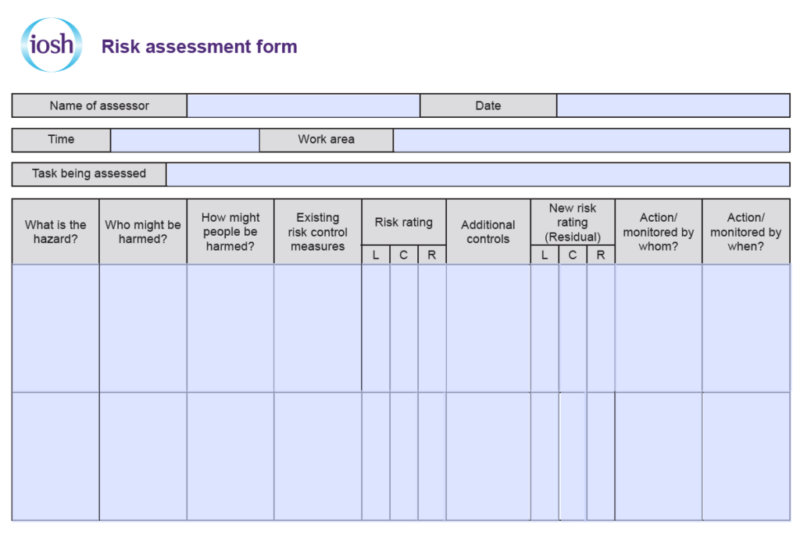
When to Conduct a Risk Assessment
You should conduct risk assessments regularly and as part of your organisation’s risk management process. This includes annual reviews, following significant workplace changes, introduction of new equipment, or in response to near-misses and incidents.
Completing the IOSH Risk Assessment Form
When carrying out your risk assessment for the IOSH Managing Safely course, the choice of workplace is flexible, as long as it allows you to identify a variety of hazards.
The IOSH Managing Safely Syllabus outlines that your assessment should cover at least four different types of hazards, categorised as follows:
Mechanical Hazards: These might include moving parts of machinery, equipment malfunctions, or other mechanical issues.
Physical Hazards: These could be things like noise, vibration, lighting conditions, or temperature extremes.
Chemical Hazards: This includes exposure to harmful chemicals, which could be in the form of solids, liquids, or gases.
Environmental Hazards: These are hazards related to the surrounding environment, such as slippery floors, uneven surfaces, or poor air quality.
Biological Hazards: These involve risks from bacteria, viruses, or other microorganisms that can cause health problems.
Organisational Hazards: These are related to workplace culture or organisational structure, such as high workload, lack of training, or poor communication.
The key is to select a workplace where you can effectively identify and assess hazards across these varied categories. This could be your regular workplace or any other suitable environment that offers the opportunity to observe and evaluate these types of hazards.
Remember, the objective of this risk assessment is not just to fulfil a course requirement but to develop practical skills in identifying and managing workplace risks effectively. Your chosen environment should therefore provide a realistic setting for applying these skills.
Understanding the IOSH Managing Safely Risk Assessment Process
Personal Details and Assessment Information
Your first task on the form is to detail personal and assessment information. This includes your role as the assessor (not the examiner), along with the date, time, and specific details about the work area and task under assessment. This could range from operational tasks in a factory to routine office activities.

Identifying Hazards
Carefully identify potential hazards in your chosen setting. Remember, a hazard is a condition or activity that can lead to adverse outcomes, not the injury or event itself.
Who Might Be Harmed?
Consider all potential people who might be harmed by the identified hazards. This includes employees, contractors, visitors, and the public, ensuring a comprehensive view of workplace safety.
How Might People Be Harmed?
Enumerate the possible injuries or harm that could result from each hazard. This section requires a balance of thoroughness and conciseness, covering all plausible outcomes.
Existing Risk Control Measures
Examine and document the existing control measures. Assess their effectiveness and identify any gaps in current safety protocols.
Risk Rating
In the IOSH Managing Safely risk assessment, the terminology used in the risk rating matrix is critical for understanding and implementing the necessary actions based on the level of risk identified. Here’s an explanation of the terminology based on the document you provided:
Use the 5×5 risk matrix to evaluate each hazard, considering both the likelihood of occurrence and the potential severity of the outcome.
Risk Rating Matrix Terms
Likelihood:
Very Unlikely: The chance of the hazardous event occurring is minimal, typically expected to occur less than once a year.
Unlikely: There is a small chance that the hazardous event might occur within a year.
Fairly Likely: The hazardous event could occur several times a year.
Likely: There is a high probability that the hazardous event will occur, possibly weekly.
Very Likely: The hazardous event is expected to occur frequently, such as daily.
Consequence:
Insignificant: No injuries are anticipated.
Minor: Injuries requiring only first aid might occur.
Moderate: Possible injuries could result in up to three days’ absence from work.
Major: Serious injuries may occur, leading to more than seven days of absence.
Catastrophic: Worst-case scenario, potentially resulting in death.
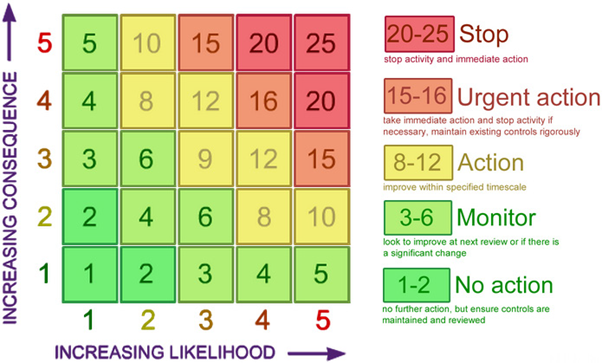
Action Level Table Terms
Risk Rating Actions:
20–25: Immediate action is required. The activity should be stopped, and immediate measures should be taken to address the hazard.
15–16: Urgent action is necessary. If needed, halt the activity, and ensure that all existing controls are applied stringently.
8–12: Timely action is needed to improve or implement control measures within a set timeframe.
3–6: Ongoing monitoring is advised. Look for improvements that can be made during the next review or if there is a significant change in the operation or process.
1–2: Generally, no further action is required other than ensuring that all current controls are effectively maintained and periodically reviewed.
The matrix serves as a guide for determining the urgency and type of response needed for various risk levels identified in a risk assessment. For implementing safety measures, it is crucial to realistically evaluate both the likelihood of occurrence and the potential consequences of each identified hazard. This structured approach helps prioritise actions to mitigate risks in the workplace effectively.
In the context of the IOSH Managing Safely course, the “Additional Controls” section of your risk assessment is where you outline strategies to mitigate identified hazards using a structured approach known as the hierarchy of control. This approach prioritises measures based on their effectiveness in risk reduction.
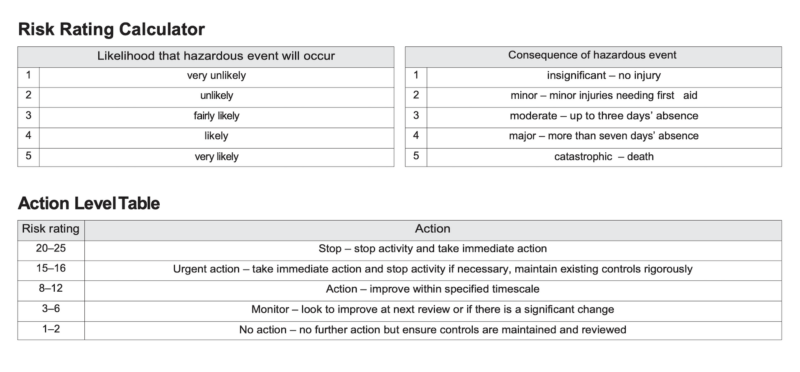
Additional Controls Explained:
Eliminate: The most effective control measure is to remove the hazard entirely from the workplace. This is not always feasible but is the optimal solution.
Reduce Hazard: If elimination is not possible, look to reduce the frequency or intensity of the hazard. This could involve modifying equipment or changing processes.
Prevent Contact: Implement barriers or controls to prevent people from coming into contact with the hazard, such as guardrails or locked enclosures.
Safe System of Work (SSOW): Develop clear, written procedures detailing safe ways to perform tasks, which may involve step-by-step instructions and safety checklists.
Personal Protective Equipment (PPE): As a last resort, provide PPE such as gloves, safety goggles, or hearing protection to reduce the risk of harm to individuals.
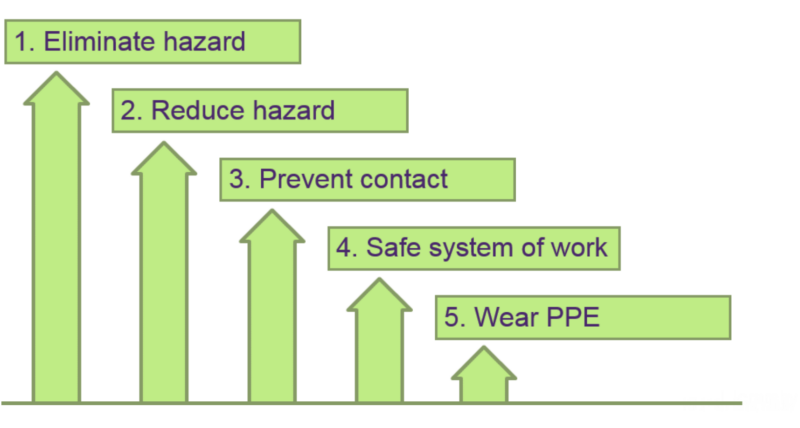
Application of Additional Controls
Training and Supervision: Ensure that all staff are adequately trained and supervised to work safely.
Engineering Controls: Use machine guards, safety locks, or other devices to enhance safety.
Maintenance: Implement a regular maintenance and inspection schedule to ensure equipment remains safe to use.
Consideration of Consequence
Equipment Adjustments: Lower equipment voltage to reduce the risk of severe electric shocks.
Chemical Substitution: Use less harmful chemicals to minimise the risk of severe consequences from exposure.It’s important to remember that for the purposes of the IOSH Managing Safely risk assessment, you should not completely remove all hazards, as the goal is to evaluate risk control effectiveness.
New Risk Rating: After implementing additional controls, reassess the risk. This new risk rating should reflect the reduced level of risk due to the controls implemented.
Action Monitoring: Identify who will be responsible for implementing and monitoring the new measures, such as a safety officer or department manager, using their job titles.
Implementation Timeline: Set a realistic deadline for when the new measures should be in place. This timeline should allow for any necessary procurement, training, or changes to be made.
Review and Closing Details: Set a review date to revisit the risk assessment and evaluate the effectiveness of the measures. At the end, sign the form and include the name of your training provider, which in this case would be ‘SWT Health and Safety’.
By following these steps and documenting them in your IOSH Managing Safely risk assessment project, you demonstrate a comprehensive understanding of risk management and control measures. This process not only helps in passing the course but also equips you with practical skills for managing workplace safety.
Scoring in the IOSH Managing Safely Risk Assessment
Understand how each section contributes to your overall score. Detailed knowledge of the scoring criteria is key to ensuring a comprehensive and compliant assessment.
| Risk Assessment Section | Marks Available | |
|---|---|---|
| Personal and Assessment Details | 1 | |
| What is the hazard? | 4 | |
| Who might be harmed? | 4 | |
| Existing Control measures | 4 | |
| Risk Rating | 4 | |
| Additional Controls | 4 | |
| New Risk Rating | 4 | |
| Action/monitored by whom? | 4 | |
| Action/monitored by when? | 4 | |
| Closing Details | 1 |
Selecting the Right Workplace for Assessment
Choose a relevant workplace environment, ensuring it allows you to identify a range of hazards across different categories, such as mechanical, environmental, and biological.
Timeframe to complete the IOSH Risk Assessment
Allocate adequate time for a thorough assessment. E-learning students typically have a two-week window, while in-person course participants will complete it within the standard course duration.
To successfully complete the IOSH Managing Safely course, participants are required to pass two separate assessments:
- Written Assessment (Test or Exam): This component consists of a 30-question written test or exam. A total of 60 points are available in this assessment, with a minimum of 36 points (60%) required to pass.
- Practical Project: The second component is a practical project, where participants must conduct a risk assessment focusing on 4 specific hazards within their workplace. This project offers a total of 38 points, with a pass mark of at least 23 points (60%).
While each assessment has a pass mark of 60%, it’s important to note that to pass the IOSH Managing Safely course overall, you must score a minimum of 60 points across both assessments combined. It’s possible, though rare, to achieve 60% in each assessment but still not meet the overall point requirement to pass the course.
In cases where a participant passes both assessments with 60% but fails to accumulate the necessary total points, the recommended course of action is to retake the practical project. This part of the assessment can often be revised to improve the score. Instructors or tutors can provide guidance on how to enhance the project to gain additional points.
Conclusion
Successfully completing the IOSH Managing Safely Risk Assessment is a critical step towards fostering a safety-conscious culture within your organisation. Use this guide to enhance your understanding and application of effective risk management practices.
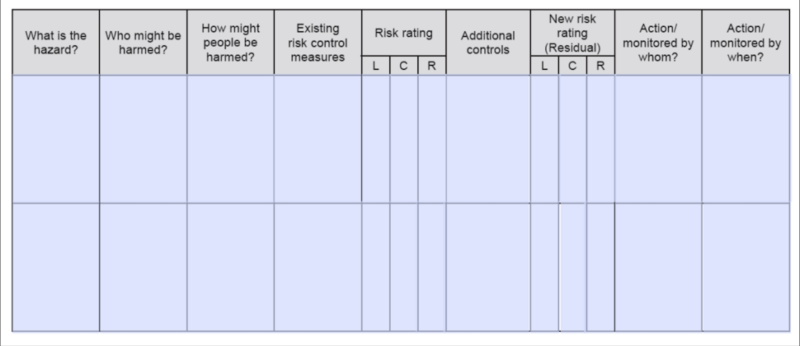
Additional Resources to help complete the IOSH Risk Assessment
For further information, refer to the IOSH official website and consult health and safety training resources.
Why Choose Southwest Health and Safety?
In a sea of health and safety training providers, Southwest Health and Safety stands out, not just for its comprehensive course offerings, but for its unwavering commitment to quality and excellence. Here’s why you should make Southwest your first choice:
- Industry Expertise: Southwest Health and Safety boasts a team of seasoned professionals who bring real-world experience into the classroom, e-learning, and virtual courses. Their depth of knowledge ensures that learners are not just equipped with theoretical understanding, but also practical insights that can be applied immediately.
- Flexible Learning Modes: Whether you prefer traditional classroom learning, the convenience of e-learning, or the dynamic environment of a virtual course, Southwest offers it all, ensuring every learner finds a method tailored to their needs.
- Outstanding Support: From the moment you enroll until you receive your certification, Southwest provides unparalleled support. Queries are addressed promptly, and additional resources are always at the ready to aid in your learning journey.
- High Success Rate: With an impressive track record of students successfully passing their examinations, Southwest Health and Safety’s teaching methods have proven their efficacy time and time again.
- Value for Money: Quality education doesn’t have to break the bank. Southwest Health and Safety offers competitive pricing without compromising on the caliber of training.
Choosing the right training provider can be the difference between merely passing an exam and truly understanding and applying health and safety principles in real-world contexts. With Southwest Health and Safety, you’re not just making a choice; you’re making an investment in your future.
